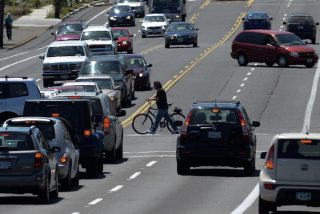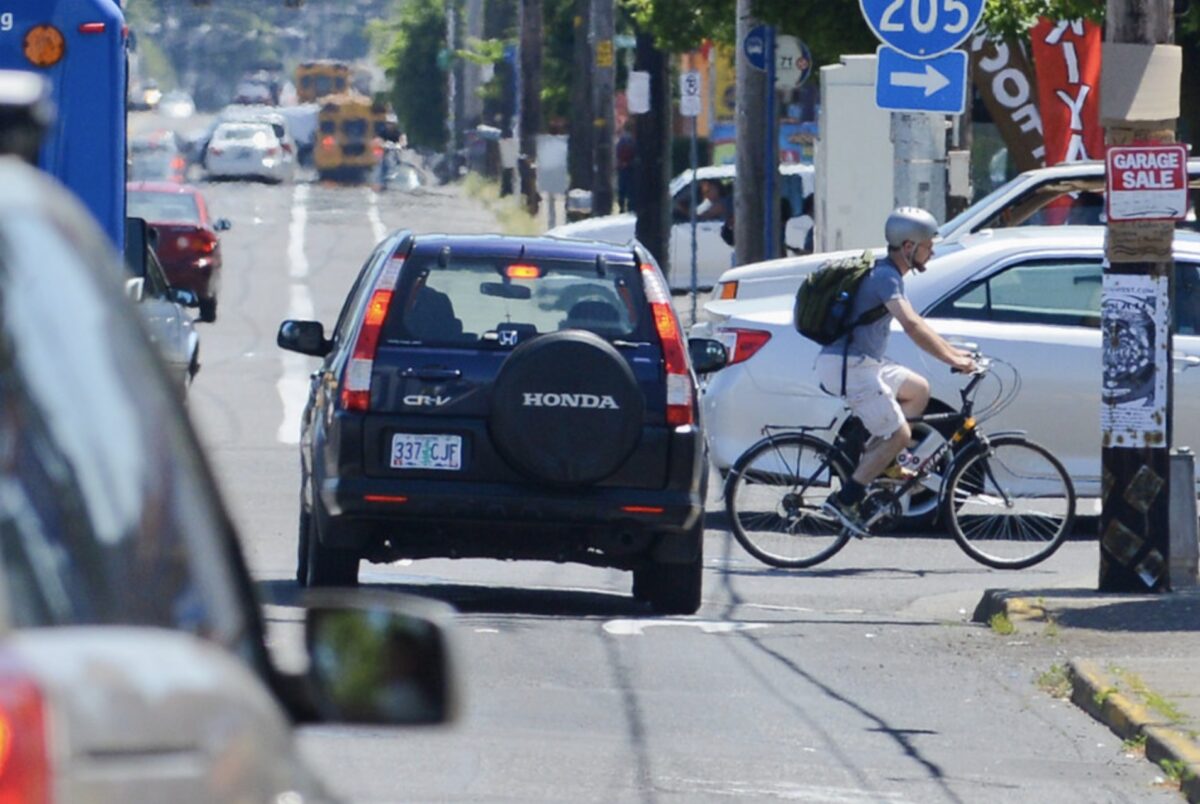
(Photo: J. Maus/BikePortland)
In what’s being hailed as an unprecedented moment for regional transportation reform, Metro Council voted unanimously on Thursday to adopt the Get Moving 2020 plan and send it to voters in November.
Centered around 17 “investment corridors,” the plan could pump nearly $8 billion into regional transportation infrastructure and programs over the next 20 years. If approved, the measure would start generating revenue in 2022 with a 0.75% payroll tax paid by employers of businesses with over 25 employees. (UPDATE: A last-minute amendment exempts all state and local government agencies.) Metro’s latest pitch has framed the proposal as a massive jobs package that will put over 37,500 people to work with high-paying construction and consulting jobs.
Metro spent over 18 months negotiating the details of this package. While it’s not perfect and has received very mixed reviews from transportation reform activists, the overall feeling seems to be that the myriad benefits of the “good” projects and programs far outweigh the few “bad” projects that made the cut.
Some of the good includes:
- $700 million for better bikeways, off-street path connection, bus rapid transit and much more on Tualatin-Valley Highway.
- $65 million to kickstart Albina Vision Trust’s plans (that are totally separate from ODOT’s I-5 Rose Quarter project).
- $540 million to makeover 82nd Avenue between Highway 224 and NE Airport Way that will lead to jurisdictional transfer from ODOT (bad) to PBOT (good).
- $9 million per year for free bus and MAX passes to all high school-aged youth in the greater Portland area.
- $11.5 million per year for “Community Stability” which includes affordable housing, main street upgrades, and anti-displacement strategies.
Advertisement
Then there’s the $150 million for the “Clackamas to Columbia” corridor that will build new roads for more driving capacity in Gresham, a new overpass on Airport Way, and $975 million for a SW Corridor MAX light rail project that’s still too car-centric and has uncertain ROI.
Beyond the projects, one big takeaway from how this proposal came together is who put it together. “With this measure we took that mold which we have been using for the last 70 to 80 years and we just broke it,” Metro Council President Lynn Peterson said during her testimony yesterday. “And in its place we relied on public engagement and a transparent process to create a measure based on the shared values and needs of this entire region.”
The Getting There Together coalition deserves high praise for their work in bending the proposal away from traditional driving and highway-centric projects and toward basic safety (like street lighting, better bike lanes and sidewalks) and major transit upgrades.
And Metro was intentional to make sure the investments went in places that will benefit low-income and people of color. 68% of the region’s people of color live in the areas targeted for funding and new infrastructure. Transit investments — including 85% of new transit signal priority projects and 59% of new bus lanes — are strongly weighted toward areas where people of color live.
For veteran environmental and social justice advocate Vivian Satterfield of Verde NW (a member of the Getting There Together Coalition), these investments are exactly what residents of northeast Portland’s Cully neighborhood have been clamoring for. During testimony at yesterday’s public hearing she said, “For low-income families and people of color living, working, learning and playing in this region, we’ve always talked about our frustrations and needs from our transportation systems… And the reality of cycling through cheap junk cars on Craigslist just to have a way to get to daily activities because our current system doesn’t get people to the places they need to go in a time they have to travel.”
In such a dark news cycle, it was heartening to see optimism and gratitude from many people like Satterfield yesterday. And the united front from Metro Council who showed no fear of threats from big business interests planning to oppose the measure was also a welcome sight.
Will it pass? Given the crowded ballot and hefty opposition, it could be very close. But these are not normal times and it’s hard to predict anything. Stay tuned.
— Jonathan Maus: (503) 706-8804, @jonathan_maus on Twitter and jonathan@bikeportland.org
— Get our headlines delivered to your inbox.
— Support this independent community media outlet with a one-time contribution or monthly subscription.


